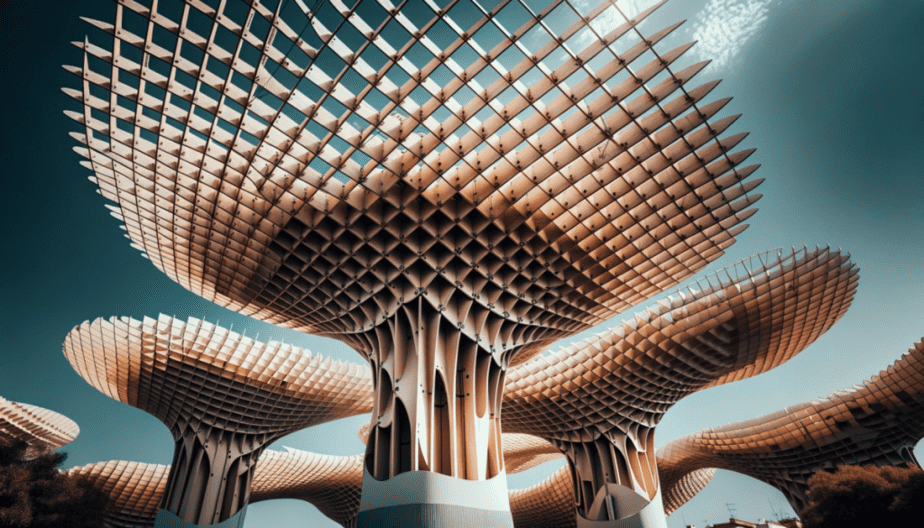Deprecated: mb_convert_encoding(): Handling HTML entities via mbstring is deprecated; use htmlspecialchars, htmlentities, or mb_encode_numericentity/mb_decode_numericentity instead in /home/u211400686/domains/tripinspain.com/public_html/wp-content/themes/acabado/functions.php on line 2160
With its rich architectural tapestry, Seville beckons travelers and design enthusiasts alike. From the ancient walls of the Alcázar to the modern lines of Metropol Parasol, the city is a living museum of styles and stories. Join us as we journey through Seville’s architectural treasures, each more captivating than the last. Read more about Seville architecture in this article.

The Magnificence of the Alcázar:

The Alcázar of Seville is not just a palace; it’s an architectural chronicle of the city’s past.
- Initially a Muslim fort, its walls have transformed from the Almohad period to the Christian reconquest. Today, it blends Mudejar, Gothic, Renaissance, and Baroque styles.
- Its intricate tilework, ornate archways, and lush gardens make it a must-visit. Every room tells a story, from the grandeur of the Hall of Ambassadors to the serenity of the Patio de las Doncellas.
- The Alcázar is not static; it evolves, with restoration projects ensuring its tales continue for future generations.
The Grandeur of Seville Cathedral:

One cannot speak of Seville’s architecture without mentioning its imposing cathedral.
- As the world’s largest Gothic cathedral, it commands attention. Its soaring bell tower, La Giralda, was originally a minaret, symbolizing the city’s blended heritage.
- Inside, the vast nave, intricate wooden choir, and the myriad of chapels showcase the pinnacle of Gothic artistry.
- The tomb of Christopher Columbus, with its dramatic statues carrying the coffin, adds a touch of history to the architectural wonder.
The Intrigue of Barrio Santa Cruz:

Winding alleys, hidden plazas, and whitewashed homes define this historic Jewish quarter.
- The district’s layout is intentional, designed for shade and privacy, reflecting a thoughtful urban design approach of the medieval era.
- Here, small churches and mansions showcase Mudejar craftsmanship, with wooden balconies and ornate ironwork adding character.
- Every corner has a story, from legends of doomed lovers to historical synagogues turned churches.
Modern Marvel: Metropol Parasol:

This wooden structure is a departure from historical architecture, a nod to Seville’s forward-thinking spirit.
- Known locally as Las Setas (The Mushrooms), its waffle-like design offers shade and houses an archaeological museum.
- The panoramic view from its walkways juxtaposes the old cityscape against modern design elements.
- It’s a testament to Seville’s embrace of contemporary architecture while honoring its past.
Triana’s Ceramic Craftsmanship:

Across the river lies Triana, known for its ceramic workshops and colorful tiles.
- Historically, Triana produced azulejos (ceramic tiles) that adorned many Sevillian buildings, adding vibrancy and artistry.
- The Ceramic Museum delves into the craft, showcasing the evolution of designs and techniques.
- Modern workshops continue the tradition of creating bespoke tiles and preserving this integral aspect of Seville’s architectural identity.
The Artistry of Plaza de España:

It’s a masterpiece of the Ibero-American Exposition of 1929, a semi-circular building with a canal.
- The Renaissance and Moorish styles blend harmoniously, with bridges representing Spain’s ancient kingdoms.
- The alcoves, adorned with azulejos, depict historical events from each Spanish province, making it an architectural history book.
- Its grandeur has caught Hollywood’s eye, becoming a backdrop for movies like Star Wars.
Flamenco’s Home: La Alameda District:
A bohemian vibe, art studios, and flamenco’s soul define this district.
- Historic mansions turned into modern art spaces showcase Seville’s adaptability.
- The area’s squares and gardens provide serene spots amidst the urban hustle.
- Here, architecture and culture intertwine, with venues hosting flamenco shows, keeping the dance form’s spirit alive.
The Waterfront’s Evolution:
Seville’s riverfront has transformed from a bustling port to a leisure hub.
- Historic warehouses now house restaurants, theaters, and galleries, exemplifying adaptive reuse.
- The riverside promenade offers views of iconic structures, from bridges to towers, tracing Seville’s maritime history.
- Modern installations like the Pelli Tower signify the city’s continuous architectural evolution.
The Mystique of Palacio de las Dueñas:
This 15th-century palace blends Gothic, Mudejar, and Renaissance elements.
- Its courtyards, gardens, and rooms are adorned with azulejos, arches, and artworks.
- The Andalusian patio, with orange trees and fountains, encapsulates Seville’s essence.
- Still in use, the palace offers a peek into aristocratic life, bridging the past with the present.
The Allure of Andalusian Homes:
Beyond monumental structures, Seville architecture is equally captivating.
- Traditional homes, with central patios and balconies, showcase Andalusian living that prioritizes family and community.
- Their designs, with cool tiles and shaded courtyards, respond to Seville’s hot climate, showcasing functionality and beauty.
- These homes, with flowering pots and wrought-iron gates, add to the city’s architectural tapestry.
Conclusion:
Seville architecture reflects its soul – a blend of cultures, eras, and aspirations. Each brick and tile tells a story, from grand palaces to humble homes. As we walk its streets, we’re not just observers; we’re time travelers, art enthusiasts, and storytellers all at once. So, the next time you’re in Seville, look beyond the obvious. Dive deep into its architectural marvels, and you’ll discover tales that books seldom tell.
